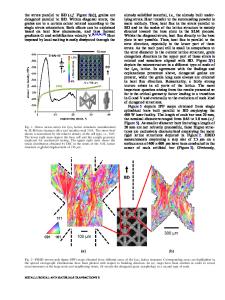Geometrical Structure of Lattice Defect-Impurity Configurations Determined by TDPAC
- PDF / 576,491 Bytes
- 7 Pages / 414 x 633.6 pts Page_size
- 35 Downloads / 339 Views
435
GEOMETRICAL STRUCTURE OF LATTICE DEFECT-IMPURITY CONFIGURATIONS DETERMINED BY TDPAC
M. DEICHER, 0. ECHT, E. RECKNAGEL AND TH. WICHERT FakultHt fUr Physik, Universitlt Konstanz, D-7750 Konstanz, Fed. Rep. Germany
ABSTRACT The perturbed angular correlation technique (TDPAC) was applied to determine the orientation of the electric field gradient tensor induced by lattice defects at the probe I lIIn. The experimental results obtained for self-interstitials, vacancies and defect clusters in Cu, Ag and Au are shown and their microscopic interpretation is discussed. 1. INTRODUCTION In this contribution we want to illustrate that the mere tagging of a defect trapped at a radioactive impurity atom by its characteristic quadrupole coupling constant VQ = eQ• Vzz/h and the asymmetry parameter n = (Vxx- Vyy)/Vzz does not make the best use of the electric field gradient (efg) in its capacity as a tensor (eQ is the nuclear quadrupole moment of the radioactive probe and Vii are the elements of the diagonalized tensor). In most cases of defect studies, using nuclear methods like M~ssbauer effect or the TDPAC technique (time differential observation of perturbed yy angular correlation) it has been omitted to determine the orientation of the efg tensor with respect to the crystallographic lattice. The orientation and the asymmetry parameter are just values which can be estimated in the framework of a simple "point charge" model, at least in case of trapped defects being not too complicated. In such a model it is assumed that the geometrical behaviour of the efg is mainly governed by the geometrical arrangement of the metal ions, i.e. by the geometry of the lattice. Then the efg is easily calculated by the sum of all efg's originating from each lattice site, so that a vacant lattice site does not give a contribution. Obviously, the absolute value of the efg is not obtainable in this way, but the measured orientation of a defect induced efg should become interpretable in this simple model. The structural information about the probe atom-defect configuration can be compared with that obtained by other methods like the diffuse scattering technique, mechanical relaxation measurements IIj or channeling measurements 12I. 2.
ORIENTATION OF THE EFG IN LOCALLY DISTORTED CUBIC METALS
The efg is mathematically represented by a symmetric and traceless 3x 3 tensor. Fig.I shows its three parameters of interest in a schematic way: "Axis", "symmetry" and "orientation". The "orientation" contains the three rotation angles to obtain a diagonalized matrix with its three components Vxx, Vyy and Vzz using the convention IVxxllVyylIIVzzI. When the efg possesses "symmetry", i.e. Vxx = Vyy or n = 0, the orientation of the tensor is presented by the one of the "axis", i.e. the component Vzz. In case of a symmetric efg and for an isomeric state with spin I = 5/2, as it holds for the 1 radioactive probe III1n/ lICd, the time dependence of the observed yy angular
436
(
r X% -r-P
/3bN -
Fig.1:
z- /
Euler Angles
c,/gor
Meaning of the different
Data Loading...











